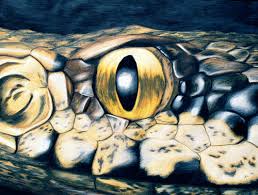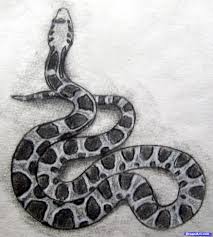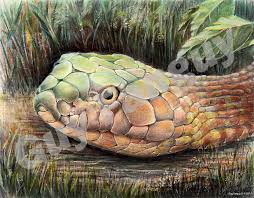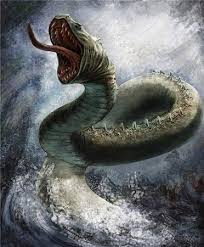Source:Goolge.com.pk
Pencil Drawings Of Snakes Biography
Nampeyo's story begins in Hano, a Pueblo established in 1696 by Hopi natives and Tewa refugees fleeing west from New Mexico after the Pueblo Revolt of 1680, during the Spanish invasions. Despite the fact that the Tewa were a warrior tribe, they were invited to remain in Hano to help protect the more peaceful Hopi villagers against raiders. By the time Nampeyo was born the two peoples were co - existing happily, having carefully maintained their individual languages and cultures despite frequent intermarriage.
The year of Nampeyo's birth is disputed - some scholars claim it was 1859, while others believe it was 1860 - but the exact date of her birth is unknown. She was born in the Hopi - Tewa village of Hano, on the First Mesa in the Hopi Reservation in what is now Northern Arizona. A child of mixed heritage, her father Qotsvema (sometimes spelled "Kotsuema") was a Hopi farmer of the Snake Clan from the nearby village of Walpi. Her mother Qotcakao (sometimes spelled "Kotsakao") was a Tewa native of Hano believed to be from either the Corn or the Tobacco Clan.
Nampeyo was given the name "Tcumana" (Snake Girl) by her paternal grandmother, to honor her father's family clan, but her Tewa name Nampeyo (Snake That Does Not Bite) was more widely used because she lived at Hano among the Tewa people. The Tewa society operated under a matriarchy, and Nampeyo became a member of her mother's clan, with any man she married expected to join her mother's family in Hano, according to Tewa tradition. Not much is known about her early life beyond the fact that she spent a great deal of time at Walpi with her paternal grandmother, a respected potter, watching her shape the large water - carrying vessels called ollas. The matriarch recognized Nampeyo's talent early on, and encouraged the young girl to learn the trade.
Apprenticeship
Pottery had been an esteemed skill in Pueblo society for more than 2,000 years, but the potters that were working when Nampeyo was a girl had lost the creative spark that had given the work of their ancestors artistic value. Women were no longer decorating the vessels they made - their status as utilitarian objects classifying them as not worth the effort it would take to adorn them. Even the basic pots used to cook food and carry water were losing favor as modern materials like metal pots and china dishware made their way into Native American culture.
The Tewa women of Hano rarely decorated their pots, but the Walpi culture regularly applied a thick slip and painted designs based on tribal beliefs and symbols. Once fired, the pieces were called "crackle ware" because of the cracked finish. The Hopi images used by Nampeyo's grandmother were a mish - mash of Spanish, Tewa, and Zuni influence - the most common image being "Mera," the rain bird. Nampeyo was not only remarkable in the level of skill she showed early on, but also in her ability to recognize the importance of reviving the ancient methods and style for the future of her people. The integrity of the Hopi designs her grandmother used had become diluted by the imagery of surrounding cultures, and it was Nampeyo's desire to restore the purity of the designs she had seen on the shards of ancient Hopi ceramic wares.
As a girl, Nampeyo learned the conventional coil - and - scrape method that her ancestors had utilized. She learned that the first step to creating a pot was to prepare the clay. She would have collected shards of clay, ground them down and softened the mixture with water. A ball of clay prepared this way was then pounded into a circular base, with the sides of the vessel being built by coiling a rope of clay upon itself in a spiral. The shape of the pot was then decided and molded, smoothed with a stone, and covered in slip - a thin mixture of water and clay that acted like a glaze. At this stage, the vessel was painted using a chewed yucca leaf as a brush to apply brown and red pigments, then fired in a kiln made of rocks or animal dung.
Nampeyo would have initially made miniature vessels in order to practice the craft, working to make them larger as her skills developed. The young potter had great natural talent, and she combined this innate ability with a rigorous work ethic - quickly making a name for herself as the finest potter on the Mesa. As her grandmother grew older, Nampeyo often finished and sometimes decorated vessels that were shaped by the older woman - a process that would be echoed later in life by Nampeyo's own daughters and granddaughters.








Pencil Drawings Of Snakes Biography
Nampeyo's story begins in Hano, a Pueblo established in 1696 by Hopi natives and Tewa refugees fleeing west from New Mexico after the Pueblo Revolt of 1680, during the Spanish invasions. Despite the fact that the Tewa were a warrior tribe, they were invited to remain in Hano to help protect the more peaceful Hopi villagers against raiders. By the time Nampeyo was born the two peoples were co - existing happily, having carefully maintained their individual languages and cultures despite frequent intermarriage.
The year of Nampeyo's birth is disputed - some scholars claim it was 1859, while others believe it was 1860 - but the exact date of her birth is unknown. She was born in the Hopi - Tewa village of Hano, on the First Mesa in the Hopi Reservation in what is now Northern Arizona. A child of mixed heritage, her father Qotsvema (sometimes spelled "Kotsuema") was a Hopi farmer of the Snake Clan from the nearby village of Walpi. Her mother Qotcakao (sometimes spelled "Kotsakao") was a Tewa native of Hano believed to be from either the Corn or the Tobacco Clan.
Nampeyo was given the name "Tcumana" (Snake Girl) by her paternal grandmother, to honor her father's family clan, but her Tewa name Nampeyo (Snake That Does Not Bite) was more widely used because she lived at Hano among the Tewa people. The Tewa society operated under a matriarchy, and Nampeyo became a member of her mother's clan, with any man she married expected to join her mother's family in Hano, according to Tewa tradition. Not much is known about her early life beyond the fact that she spent a great deal of time at Walpi with her paternal grandmother, a respected potter, watching her shape the large water - carrying vessels called ollas. The matriarch recognized Nampeyo's talent early on, and encouraged the young girl to learn the trade.
Apprenticeship
Pottery had been an esteemed skill in Pueblo society for more than 2,000 years, but the potters that were working when Nampeyo was a girl had lost the creative spark that had given the work of their ancestors artistic value. Women were no longer decorating the vessels they made - their status as utilitarian objects classifying them as not worth the effort it would take to adorn them. Even the basic pots used to cook food and carry water were losing favor as modern materials like metal pots and china dishware made their way into Native American culture.
The Tewa women of Hano rarely decorated their pots, but the Walpi culture regularly applied a thick slip and painted designs based on tribal beliefs and symbols. Once fired, the pieces were called "crackle ware" because of the cracked finish. The Hopi images used by Nampeyo's grandmother were a mish - mash of Spanish, Tewa, and Zuni influence - the most common image being "Mera," the rain bird. Nampeyo was not only remarkable in the level of skill she showed early on, but also in her ability to recognize the importance of reviving the ancient methods and style for the future of her people. The integrity of the Hopi designs her grandmother used had become diluted by the imagery of surrounding cultures, and it was Nampeyo's desire to restore the purity of the designs she had seen on the shards of ancient Hopi ceramic wares.
As a girl, Nampeyo learned the conventional coil - and - scrape method that her ancestors had utilized. She learned that the first step to creating a pot was to prepare the clay. She would have collected shards of clay, ground them down and softened the mixture with water. A ball of clay prepared this way was then pounded into a circular base, with the sides of the vessel being built by coiling a rope of clay upon itself in a spiral. The shape of the pot was then decided and molded, smoothed with a stone, and covered in slip - a thin mixture of water and clay that acted like a glaze. At this stage, the vessel was painted using a chewed yucca leaf as a brush to apply brown and red pigments, then fired in a kiln made of rocks or animal dung.
Nampeyo would have initially made miniature vessels in order to practice the craft, working to make them larger as her skills developed. The young potter had great natural talent, and she combined this innate ability with a rigorous work ethic - quickly making a name for herself as the finest potter on the Mesa. As her grandmother grew older, Nampeyo often finished and sometimes decorated vessels that were shaped by the older woman - a process that would be echoed later in life by Nampeyo's own daughters and granddaughters.
Pencil Drawings Of Snakes
Pencil Drawings Of Snakes
Pencil Drawings Of Snakes
Pencil Drawings Of Snakes
Pencil Drawings Of Snakes
Pencil Drawings Of Snakes
Pencil Drawings Of Snakes
Pencil Drawings Of Snakes
Pencil Drawings Of Snakes
Drawing A Snake
How To Draw A Cartoon Snake
No comments:
Post a Comment